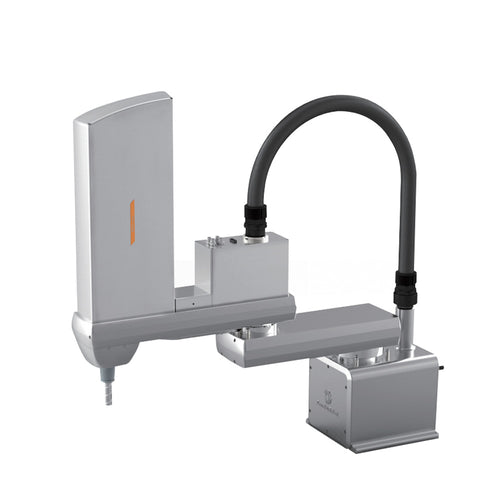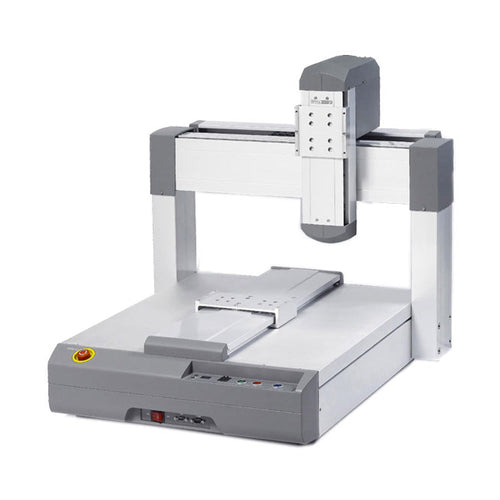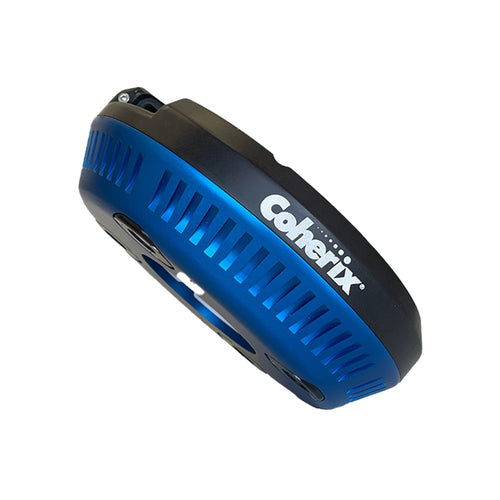As precision, speed, and efficiency become more and more important in today's manufacturing processes, robots and some degree of automation are growing in popularity. Especially when it comes to material dispensing when incorrect application could lead to bond failure or other issues, and wasted materials quickly add up in cost.
Two types of robots quickly come to mind for dispensing applications—SCARA (Selective Compliance Assembly Robot Arm) and Cartesian robots. These machines can increase throughput and improve efficiency. But how do you know which one to choose? Our team of material dispensers explains the difference between Cartesian and SCARA robots as well as which dispensing applications are best for each.
SCARA Robots
SCARA robots, or Selective Compliance Assembly Robot Arms, are robot arms that work on a 4-axis design—X, Y, Z, and Theta. They have selective compliance as they move easily in the X and Y planes (side-to-side and front-to-back directions), but they are limited in their movements in the Z plane (up and down).
This orientation makes them great for high-speed pick-and-place operations, product assembly, and material dispensing. They are commonly used in the production of electronics, medical devices, and consumer goods.
Pros
-
Wide Range of Motion- SCARA robot arms are able to easily move side to side, front to back, and at different angles. They can be great for applications that involve more complex dispensing patterns or varied positioning.
- High-Speed Capabilities- SCARA robots are compatible with high-speed dispensing applications.
-
Complex Task Execution- These types of robots can be programmed for more complex motions and dispensing patterns.
-
Compact Design- SCARA dispensing robots are commonly mounted on pedestals and have compact designs that allow them to function easily in workspaces with limited floor space.
Cons
-
Limited Payload Capacity- The payload capacity of SCARA robot arms is limited to what the joint at the end of the arm can handle.
-
Limited Application Size- SCARA robots are restricted in their working space because they can only go so far as their reach. Consequently, they are not usually made for larger dispensing applications.
Cartesian Robots
Cartesian robots, also called gantry robots or linear robots, are robots that move in straight lines along the X, Y, and Z axes. They work from an overhead, rectangular grid and use motors and linear actuators to move into position. The direct-drive motion control setup lends itself to repeatable and precise dispensing. Common applications for Cartesian dispensing robots include the manufacturing of medical devices, automotive components, and electronics.
Pros
-
Great Precision- Cartesian coordinate robots are known for their great positional accuracy. They are ideal for precise and consistent material and adhesive dispensing.
-
Scalable in Size- While SCARA robots are restricted to their reach on a pedestal, Cartesian robots can have grids that are configured to large sizes and can move parts over long distances.
-
Larger Payload- Because of their overhead grid setup, Cartesian robot arms have a larger payload than SCARA robots for dispensing.
Cons
-
Limited Range of Motion- Unlike SCARA dispensing robots, Cartesian robots are restricted to linear motion. They cannot rotate or move in more circular or arc movements, which limits their application capabilities.
-
Larger Workspaces- Often, Cartesian gantry robots require a larger surface area of space for operation than a SCARA robot.
- Slower Speeds- Cartesian robots may not be ideal for high-speed dispensing applications, as the machine may need to travel great distances across its grid.
Differences Between SCARA Robots Vs. Cartesian Robots for Dispensing
Each type of robot has its pros and cons, but it can be hard to know which is right for your needs. To help distinguish these differences between SCARA and Cartesian robots, we created the chart below.
| Category | SCARA Robot | Cartesian Robot |
| Range of Motion | Can move in curves and arcs | Restricted to linear motion |
| Payload | Limited | Can handle a higher payload |
| Speed & Cycle Time | Generally faster | May be slower |
| Precision | Small variations possible | High level of precision |
| Workspace | Compact | Can take up more space |
| Scalability | Not easily scalable, limited by reach | Easily scalable |
| Integration | May be harder to integrate | Easy to integrate |
One of the biggest differences between a SCARA robot and a Cartesian robot is their range of motion and dispensing pattern capabilities. SCARA robots are ideal for curves and arcs, while Cartesian dispensing robots are restricted to straight line patterns.
Another difference between SCARA versus Cartesian robots is their payload capacity. The payload of SCARA robots is limited by the joint. On the other hand, Cartesian coordinate robots are anchored by the grid system and can handle more weight.
When looking at the two, it is important to compare SCARA robot speed versus Cartesian robot speed. SCARA robots are generally faster because of their compact design. On the other hand, Cartesian robots may have to travel longer distances in larger grids which can slow down their work speed.
There may also be a slight difference in precision. Cartesian robots are known for their precision and accuracy because of their rigid frame and linear motion. While still accurate, SCARA robots may have small variations when working in applications with a longer reach or at a higher speed.
Workspace and scalability are other differentiating factors when considering SCARA robots versus Cartesian robots. SCARA robots are compact and well-suited for smaller workspaces, but they are not easily scalable. Cartesian robots can be easily scaled for much larger applications but often take up a lot more floor space.
Finally, Cartesian robots tend to be simpler in design. Their linear motion can be easy for users new to automation, and they tend to be easy to integrate into existing systems. Because SCARA robots can perform more complex dispensing patterns, they can be slightly harder to program and integrate.
How to Choose
When deciding between a SCARA and a Cartesian robot for a dispensing application, you will want to consider the following:
- Dispensing pattern
- Orientation and range of motion
- Payload
- Production speed
- Precision
- Workspace
In general, SCARA robots are best for dispensing applications with:
- Dispensing patterns that are non-linear
- Higher production speeds
- Smaller workspaces and dispensing applications
SCARA robots are ideal for dispensing applications involving circular or curved patterns and compact workspaces. They are also a good choice for companies looking for high-speed production.
Browse our selection of SCARA robots for dispensing.
In general, Cartesian robots are best for dispensing applications with:
- Larger dispensing areas
- Linear dispensing patterns
- Higher payloads
- Precision as a priority
Cartesian robots are best suited for linear dispensing applications with large surface areas or heavier payloads. They can be good for businesses where precision is a top priority.
Browse our selection of Cartesian adhesive robots.
You can also browse our full collection of adhesive dispensing robots.
Need More Help?
We understand that every application is different, and it can be hard to know the best equipment for your needs. Whether you are looking for a personalized recommendation for your specific process requirements or have questions about integration into your system, we want to help. When you contact us, you will get connected with a dispensing expert who can help answer your questions.












